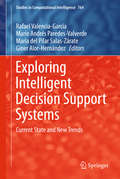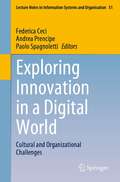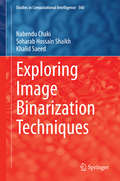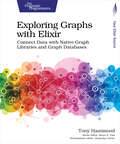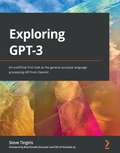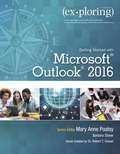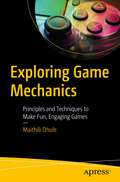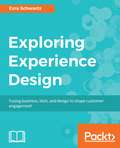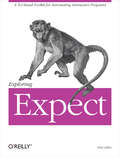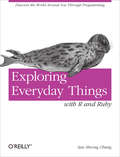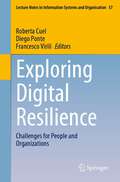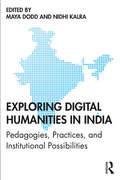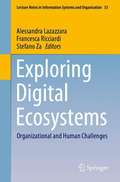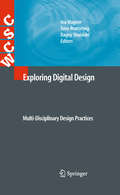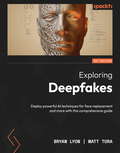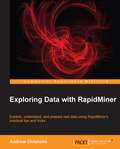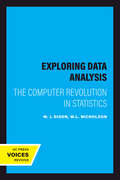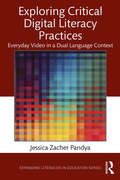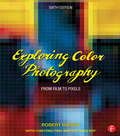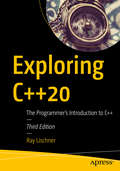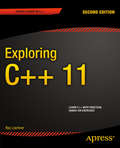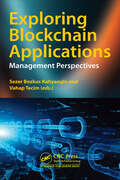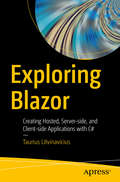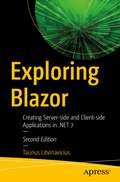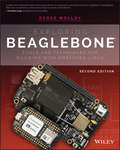- Table View
- List View
Exploring Intelligent Decision Support Systems: Current State and New Trends (Studies in Computational Intelligence #764)
by Giner Alor-Hernández María del Pilar Salas-Zárate Mario Andrés Paredes-Valverde Rafael Valencia-GarcíaThis book presents innovative and high-quality research regarding advanced decision support systems (DSSs). It describes the foundations, methods, methodologies, models, tools, and techniques for designing, developing, implementing and evaluating advanced DSSs in different fields, including finance, health, emergency management, industry and pollution control. Decision support systems employ artificial intelligence methods to heuristically address problems that are cannot be solved using formal techniques. In this context, technologies such as the Semantic Web, linked data, big data, and machine learning are being applied to provide integrated support for individuals and organizations to make more rational decisions. The book is organized into two parts. The first part covers decision support systems for industry, while the second part presents case studies related to clinical emergency management and pollution control.
Exploring Innovation in a Digital World: Cultural and Organizational Challenges (Lecture Notes in Information Systems and Organisation #51)
by Federica Ceci Andrea Prencipe Paolo SpagnolettiInnovation is occurring at a rapid pace in digital work and demands increasing attention from academic scholars. In line with this demand, this book aims to provide an overview of recent advances in studies of innovation and technology in the digital space. The book addresses the cultural elements influencing the diffusion and adoption of digital technologies, the pervasive role of social media, the organizational challenges of digital transformations, and finally specific emerging technologies such as artificial intelligence and distributed ledger technology. The plurality of views offered makes this book particularly relevant to practitioners, academics, and policymakers, and provides an up-to-date view of the latest developments in Information Systems. It gathers a selection of the best papers (double-blind peer-reviewed) presented at the annual conference of the Italian AIS Chapter in October 2020 in Pescara, Italy.
Exploring Image Binarization Techniques
by Nabendu Chaki Soharab Hossain Shaikh Khalid SaeedThe book focuses on an image processing technique known as binarization. It provides a comprehensive survey over existing binarization techniques for both document and graphic images. A number of evaluation techniques have been presented for quantitative comparison of different binarization methods. The book provides results obtained comparing a number of standard and widely used binarization algorithms using some standard evaluation metrics. The comparative results presented in tables and charts facilitates understanding the process. In addition to this, the book presents techniques for preparing a reference image which is very much important for quantitative evaluation of the binarization techniques. The results are produced taking image samples from standard image databases.
Exploring Graphs with Elixir
by Tony HammondData is everywhere - it's just not very well connected, which makes it super hard to relate dataset to dataset. Using graphs as the underlying glue, you can readily join data together and create navigation paths across diverse sets of data. Add Elixir, with its awesome power of concurrency, and you'll soon be mastering data networks. Learn how different graph models can be accessed and used from within Elixir and how you can build a robust semantics overlay on top of graph data structures. We'll start from the basics and examine the main graph paradigms. Get ready to embrace the world of connected data! Graphs provide an intuitive and highly flexible means for organizing and querying huge amounts of loosely coupled data items. These data networks, or graphs in math speak, are typically stored and queried using graph databases. Elixir, with its noted support for fault tolerance and concurrency, stands out as a language eminently suited to processing sparsely connected and distributed datasets. Using Elixir and graph-aware packages in the Elixir ecosystem, you'll easily be able to fit your data to graphs and networks, and gain new information insights. Build a testbed app for comparing native graph data with external graph databases. Develop a set of applications under a single umbrella app to drill down into graph structures. Build graph models in Elixir, and query graph databases of various stripes - using Cypher and Gremlin with property graphs and SPARQL with RDF graphs. Transform data from one graph modeling regime to another. Understand why property graphs are especially good at graph traversal problems, while RDF graphs shine at integrating different semantic models and can scale up to web proportions. Harness the outstanding power of concurrent processing in Elixir to work with distributed graph datasets and manage data at scale. What You Need: To follow along with the book, you should have Elixir 1.10+ installed. The book will guide you through setting up an umbrella application for a graph testbed using a variety of graph databases for which Java SDK 8+ is generally required. Instructions for installing the graph databases are given in an appendix.
Exploring GPT-3: An unofficial first look at the general-purpose language processing API from OpenAI
by Steve Tingiris Bret KinsellaGet started with GPT-3 and the OpenAI API for natural language processing using JavaScript and PythonKey FeaturesUnderstand the power of potential GPT-3 language models and the risks involvedExplore core GPT-3 use cases such as text generation, classification, and semantic search using engaging examplesPlan and prepare a GPT-3 application for the OpenAI review process required for publishing a live applicationBook DescriptionGenerative Pre-trained Transformer 3 (GPT-3) is a highly advanced language model from OpenAI that can generate written text that is virtually indistinguishable from text written by humans. Whether you have a technical or non-technical background, this book will help you understand and start working with GPT-3 and the OpenAI API. If you want to get hands-on with leveraging artificial intelligence for natural language processing (NLP) tasks, this easy-to-follow book will help you get started. Beginning with a high-level introduction to NLP and GPT-3, the book takes you through practical examples that show how to leverage the OpenAI API and GPT-3 for text generation, classification, and semantic search. You'll explore the capabilities of the OpenAI API and GPT-3 and find out which NLP use cases GPT-3 is best suited for. You'll also learn how to use the API and optimize requests for the best possible results. With examples focusing on the OpenAI Playground and easy-to-follow JavaScript and Python code samples, the book illustrates the possible applications of GPT-3 in production. By the end of this book, you'll understand the best use cases for GPT-3 and how to integrate the OpenAI API in your applications for a wide array of NLP tasks.What you will learnUnderstand what GPT-3 is and how it can be used for various NLP tasksGet a high-level introduction to GPT-3 and the OpenAI APIImplement JavaScript and Python code examples that call the OpenAI APIStructure GPT-3 prompts and options to get the best possible resultsSelect the right GPT-3 engine or model to optimize for speed and cost-efficiencyFind out which use cases would not be suitable for GPT-3Create a GPT-3-powered knowledge base application that follows OpenAI guidelinesWho this book is forExploring GPT-3 is for anyone interested in natural language processing or learning GPT-3 with or without a technical background. Developers, product managers, entrepreneurs, and hobbyists looking to get to grips with NLP, AI, and GPT-3 will find this book useful. Basic computer skills are all you need to get the most out of this book.
Exploring Getting Started with Microsoft Outlook 2016 (Exploring for Office 2016 Ser.)
by Mary Anne Poatsy Robert Grauer Barbara StoverThe goal of the Exploring series is to move students beyond the point-and-click, to understanding the why and how behind each skill. And because so much learning takes place outside of the classroom, this series provides learning tools that students can access anywhere, anytime. Students go to college now with a different set of skills than they did years ago. With this in mind, the Exploring series seeks to move students beyond the basics of the software at a faster pace, without sacrificing coverage of the fundamental skills that everyone needs to know.
Exploring Game Mechanics: Principles and Techniques to Make Fun, Engaging Games
by Maithili DhuleLearn simple yet powerful, modern-day techniques used in various gaming genres, including casual and puzzle, strategy and simulation, action-adventure, and role-playing. This book is your pocket-sized guide to designing interesting and engaging mechanics for any type of game. Exploring Game Mechanics is a cornucopia of concepts related to gameplay mechanics that you can use to create games that are fun and rewarding to play. Dive into key gameplay elements that improve the player experience, such as implementing in-game tutorials, controlling the flow of player-choice-based games, and building a game narrative through storytelling. Understand how to establish the game’s end goal for the player to work towards by creating quests, missions, and objectives. Explore the key ideas behind creating immersive game worlds, generating better NPCs and enemies, and controlling the in-game economy. Finally, discover the unique mechanics that make established industry games so successful. What You Will LearnDiscover the key elements that make gameplay immersive and entertainingDevelop players and NPCs through customization and levelling up Gain insight into the tried-and-tested concepts behind modern-day games Who Is This Book ForGame development enthusiasts with little to no knowledge of game mechanics will find the content informative and useful.
Exploring Experience Design
by Ezra SchwartzLearn how to unify Customer Experience, User Experience and more to shape lasting customer engagement in a world of rapid change. About This Book • An introductory guide to Experience Design that will help you break into XD as a career by gaining A strong foundational knowledge • Get acquainted with the various phases of a typical Experience Design workflow • Work through the key process and techniques in XD, supported by most of the common use cases Who This Book Is For This book is for designers who wish to enter the field of UX Design, especially Programmers, Content Strategists, and Organizations keen to understand the core concepts of UX Design. What You Will Learn • Understand why Experience Design (XD) is at the forefront of business priorities, as organizations race to innovate products and services in order to compete for customers in a global economy driven by technology and change • Get motivated by the numerous professional opportunities that XD opens up for practitioners in wide-ranging domains, and by the stories of real XD practitioners • Understand what experience is, how experiences are designed, and why they are effective • Gain knowledge of user-centered design principles, methodologies, and best practices that will improve your product (digital or physical) • Get to know your X's and D's—understand the differences between XD and UX, CX, IxD, IA, SD, VD, PD, and other design practices In Detail We live in an experience economy in which interaction with products is valued more than owning them. Products are expected to engage and delight in order to form the emotional bonds that forge long-term customer loyalty: Products need to anticipate our needs and perform tasks for us: refrigerators order food, homes monitor energy, and cars drive autonomously; they track our vitals, sleep, location, finances, interactions, and content use; recognize our biometric signatures, chat with us, understand and motivate us. Beautiful and easy to use, products have to be fully customizable to match our personal preferences. Accomplishing these feats is easier said than done, but a solution has emerged in the form of Experience design (XD), the unifying approach to fusing business, technology and design around a user-centered philosophy. This book explores key dimensions of XD: Close collaboration among interdisciplinary teams, rapid iteration and ongoing user validation. We cover the processes, methodologies, tools, techniques and best-practices practitioners use throughout the entire product development life-cycle, as ideas are transformed to into positive experiences which lead to perpetual customer engagement and brand loyalty. Style and approach An easy-to-understand guide, filled with real-world use cases on process, design, and techniques, helping you build a strong foundation in Experience Design.
Exploring Expect
by Don LibesExpect is quickly becoming a part of every UNIX user's toolbox. It allows you to automate Telnet, FTP, passwd, rlogin, and hundreds of other applications that normally require human interaction. Using Expect to automate these applications will allow you to speed up tasks and, in many cases, solve new problems that you never would have even considered before. For example, you can use Expect to test interactive programs with no changes to their interfaces. Or wrap interactive programs with Motif-like front-ends to control applications by buttons, scrollbars, and other graphic elements with no recompilation of the original programs. You don't even need the source code! Expect works with remote applications, too. Use it to tie together Internet applications including Telnet, Archie, FTP, Gopher, and Mosaic. Don Libes is the creator of Expect as well as the author of this book. In Exploring Expect, he provides a comprehensive tutorial on all of Expect's features, allowing you to put it immediately to work on your problems. In a down-to-earth and humorous style, he provides numerous examples of challenging real-world applications and how they can be automated using Expect to save you time and money. Expect is the first of a new breed of programs based on Tcl, the Tool Command Language that is rocking the computer science community. This book provides an introduction to Tcl and describes how Expect applies Tcl's power to the new field of interaction automation. Whether your interest is in Expect or interaction automation or you simply want to learn about Tcl and see how it has been used in real software, you will find Exploring Expect a treasure trove of easy-to-understand and valuable information.
Exploring Everyday Things with R and Ruby
by Sau Sheong ChangIf you're curious about how things work, this fun and intriguing guide will help you find real answers to everyday problems. By using fundamental math and doing simple programming with the Ruby and R languages, you'll learn how to model a problem and work toward a solution. All you need is a basic understanding of programming. After a quick introduction to Ruby and R, you'll explore a wide range of questions by learning how to assemble, process, simulate, and analyze the available data. You'll learn to see everyday things in a different perspective through simple programs and common sense logic. Once you finish this book, you can begin your own journey of exploration and discovery. Here are some of the questions you'll explore: Determine how many restroom stalls can accommodate an office with 70 employees Mine your email to understand your particular emailing habits Use simple audio and video recording devices to calculate your heart rate Create an artificial society--and analyze its behavioral patterns to learn how specific factors affect our real society
Exploring Digital Resilience: Challenges for People and Organizations (Lecture Notes in Information Systems and Organisation #57)
by Roberta Cuel Diego Ponte Francesco ViriliThis book explores multidimensional issues concerning digital resilience and analyzes how people and organizations maintain, enhance and protect value stemming from digital technologies. Society is now heading for a future in which organizations and people will increasingly depend on digital technologies, yet to date many are still unaware of the scale and risks associated with the digital transformation. As a result, there is an urgent need for digital resilience to drive a fundamental shift in the way people and organizations understand digital technologies, risks and opportunities.The book gathers a selection of the best papers presented at the annual conference of the Italian chapter of AIS, which took place in Trento, Italy, in October 2021. The diverse range of views put forward by the authors makes it particularly relevant for scholars and practitioners interested in organization, and for all of us living in the digital transformation era.
Exploring Digital Humanities in India: Pedagogies, Practices, and Institutional Possibilities
by Maya Dodd Nidhi KalraThis book explores the emergence of digital humanities in the Indian context. It looks at how online and digital resources have transformed classroom and research practices. It examines some fundamental questions: What is digital humanities? Who is a digital humanist? What is its place in the Indian context? The chapters in the volume: • study the varied practices and pedagogies involved in incorporating the ‘digital’ into traditional classrooms; • showcase how researchers across disciplinary lines are expanding their scope of research, by adding a ‘digital’ component to update their curriculum to contemporary times; • highlight how this has also created opportunities for researchers to push the boundaries of their pedagogy and encouraged students to create ‘live projects’ with the aid of digital platforms; and • track changes in the language of research, documentation, archiving and reproduction as new conversations are opening up across Indian languages. A major intervention in the social sciences and humanities, this book will be of great interest to scholars and researchers of media studies, especially new and digital media, education, South Asian studies and cultural studies.
Exploring Digital Ecosystems: Organizational and Human Challenges (Lecture Notes in Information Systems and Organisation #33)
by Francesca Ricciardi Stefano Za Alessandra LazazzaraThe recent surge of interest in digital ecosystems is not only transforming the business landscape, but also poses several human and organizational challenges. Due to the pervasive effects of the transformation on firms and societies alike, both scholars and practitioners are interested in understanding the key mechanisms behind digital ecosystems, their emergence and evolution. In order to disentangle such factors, this book presents a collection of research papers focusing on the relationship between technologies (e.g. digital platforms, AI, infrastructure) and behaviours (e.g. digital learning, knowledge sharing, decision-making). Moreover, it provides critical insights into how digital ecosystems can shape value creation and benefit various stakeholders. The plurality of perspectives offered makes the book particularly relevant for users, companies, scientists and governments. The content is based on a selection of the best papers – original double-blind peer-reviewed contributions – presented at the annual conference of the Italian chapter of the AIS, which took place in Pavia, Italy in October 2018.
Exploring Digital Design
by Dagny Stuedahl Tone Bratteteig Ina WagnerExploring Digital Design takes a multi-disciplinary look at digital design research where digital design is embedded in a larger socio-cultural context. Working from socio-technical research areas such as Participatory Design (PD), Computer Supported Cooperative Work (CSCW) and Human-Computer Interaction (HCI), the book explores how humanities offer new insights into digital design, and discusses a variety of digital design research practices, methods, and theoretical approaches spanning established disciplinary borders. The aim of the book is to explore the diversity of contemporary digital design practices in which commonly shared aspects are interpreted and integrated into different disciplinary and interdisciplinary conversations. It is the conversations and explorations with humanities that further distinguish this book within digital design research. Illustrated with real examples from digital design research practices from a variety of research projects and from a broad range of contexts Exploring Digital Design offers a basis for understanding the disciplinary roots as well as the interdisciplinary dialogues in digital design research, providing theoretical, empirical, and methodological sources for understanding digital design research. The first half of the book Exploring Digital Design is authored as a multi-disciplinary approach to digital design research, and represents novel perspectives and analyses in this research. The contributors are Gunnar Liestøl, Andrew Morrison and Christina Mörtberg in addition to the editors. Although primarily written for researchers and graduate students, digital design practioners will also find the book useful. Overall, Exploring Digital Design provides an excellent introduction to, and resource for, research into digital design.
Exploring Deepfakes: Deploy powerful AI techniques for face replacement and more with this comprehensive guide
by Bryan Lyon Matt ToraMaster the innovative world of deepfakes and generative AI for face replacement with this full-color guidePurchase of the print or Kindle book includes a free PDF eBookKey FeaturesUnderstand what deepfakes are, their history, and how to use the technology ethicallyGet well-versed with the workflow and processes involved to create your own deepfakesLearn how to apply the lessons and techniques of deepfakes to your own problemsBook DescriptionApplying Deepfakes will allow you to tackle a wide range of scenarios creatively.Learning from experienced authors will help you to intuitively understand what is going on inside the model. You'll learn what deepfakes are and what makes them different from other machine learning techniques, and understand the entire process from beginning to end, from finding faces to preparing them, training the model, and performing the final swap.We'll discuss various uses for face replacement before we begin building our own pipeline. Spending some extra time thinking about how you collect your input data can make a huge difference to the quality of the final video. We look at the importance of this data and guide you with simple concepts to understand what your data needs to really be successful.No discussion of deepfakes can avoid discussing the controversial, unethical uses for which the technology initially became known. We'll go over some potential issues, and talk about the value that deepfakes can bring to a variety of educational and artistic use cases, from video game avatars to filmmaking.By the end of the book, you'll understand what deepfakes are, how they work at a fundamental level, and how to apply those techniques to your own needs.What you will learnGain a clear understanding of deepfakes and their creationUnderstand the risks of deepfakes and how to mitigate themCollect efficient data to create successful deepfakesGet familiar with the deepfakes workflow and its stepsExplore the application of deepfakes methods to your own generative needsImprove results by augmenting data and avoiding overtrainingExamine the future of deepfakes and other generative AIsUse generative AIs to increase video content resolutionWho this book is forThis book is for AI developers, data scientists, and anyone looking to learn more about deepfakes or techniques and technologies from Deepfakes to help them generate new image data. Working knowledge of Python programming language and basic familiarity with OpenCV, Pillow, Pytorch, or Tensorflow is recommended to get the most out of the book.
Exploring Data with RapidMiner
by Andrew ChisholmA step-by-step tutorial style using examples so that users of different levels will benefit from the facilities offered by RapidMiner.If you are a computer scientist or an engineer who has real data from which you want to extract value, this book is ideal for you. You will need to have at least a basic awareness of data mining techniques and some exposure to RapidMiner.
Exploring Data Analysis: The Computer Revolution in Statistics
by W. J. Dixon W. L. Nicholson xxx National Bureau of StandardsThis title is part of UC Press's Voices Revived program, which commemorates University of California Press’s mission to seek out and cultivate the brightest minds and give them voice, reach, and impact. Drawing on a backlist dating to 1893, Voices Revived makes high-quality, peer-reviewed scholarship accessible once again using print-on-demand technology. This title was originally published in 1974.This title is part of UC Press's Voices Revived program, which commemorates University of California Press’s mission to seek out and cultivate the brightest minds and give them voice, reach, and impact. Drawing on a backlist dating to 1893, Voices Revived</DIV
Exploring Critical Digital Literacy Practices: Everyday Video in a Dual Language Context (Expanding Literacies in Education)
by Jessica Zacher PandyaIn this book, Jessica Zacher Pandya examines the everyday videomaking practices of students in a dual language, under-resourced school in order to explore the ways children interrogate their worlds, the kinds of identities they craft, and the language and literacy learning practices that emerge from digital video production. Focusing on vulnerable populations who are often left out of innovative in- and out-of-school digital media projects—including English language learners, immigrants, and children with special needs—this book offers an expanded understanding of children’s critical digital literacy practices, and shows how videomaking in the regular curriculum affords opportunities for redistributive social justice. Weaving together pedagogical, methodological, social, and political concerns into her examination of a real-world context, Pandya offers a practical and informative analysis of making videos in schools; examines the impact of videomaking on students’ language use and agency; and adds significantly to current theorizations of digital and new literacies.
Exploring Color Photography: From Film to Pixels
by Robert HirschRobert Hirsch's Exploring Color Photography is the thinking photographer's guide to color imagemaking. Now in its sixth edition, this pioneering text clearly and concisely instructs students and intermediate photographers in the fundamental aesthetic and technical building blocks needed to create thought-provoking digital and analog color photographs. Taking both a conceptual and pragmatic approach, the book avoids getting bogged down in complex, ever-changing technological matters, allowing it to stay fresh and engaging. Known as the Bible of Color Photography, its stimulating assignments encourage students to be adventurous and to take responsibility for learning and working independently. The emphasis on design and postmodern theoretical concepts stresses the thought process behind the creation of intriguing images. It's extensive and inspiring collection of images and accompanying captions allow makers to provide insight into how photographic methodology was utilized to visualize and communicate their objectives. The text continues to deliver inspiring leadership in the field of color photography with the latest accurate information, ideas, commentary, history, a diverse collection of contemporary images, and expanded cellphone photography coverage. A "Problem Solving and Writing" chapter offers methods and exercises that help one learn to be a visual problem solver and to discuss and write succinctly about the concepts at the foundation of one's work. Exploringcolorphotography.com, the companion website, has been revamped and updated to feature more student and teacher resources, including a new web-based timeline: As It Happened: A Chronological History of Color Photography.
Exploring C++20: The Programmer's Introduction to C++
by Ray LischnerDiscover everything you need to know about C++ in a logical progression of small lessons that you can work through as quickly or as slowly as you need. This book divides C++ up into bite-sized chunks that will help you learn the language one step at a time. Fully updated to include C++20, it assumes no familiarity with C++ or any other C-based language. Exploring C++20 acknowledges that C++ can be a complicated language, so rather than baffle you with complex chapters explaining functions, classes, and statements in isolation you’ll focus on how to achieve results. By learning a little bit of this and a little of that you’ll soon have amassed enough knowledge to be writing non-trivial programs and will have built a solid foundation of experience that puts those previously baffling concepts into context.In this fully-revised third edition of Exploring C++, you’ll learn how to use the standard library early in the book. Next, you’ll work with operators, objects, and data-sources in increasingly realistic situations. Finally, you’ll start putting the pieces together to create sophisticated programs of your own design confident that you’ve built a firm base of experience from which to grow.What You Will Learn Grasp the basics, including compound statements, modules, and more Work with custom types and see how to use them Write useful algorithms, functions, and moreDiscover the latest C++ 20 features, including concepts, modules, and ranges Apply your skills to projects that include a fixed-point numbers and body-mass index applications Carry out generic programming and apply it in a practical project Exploit multiple inheritance, traits/policies, overloaded functions, and metaprogramming Who This Book Is ForExperienced programmers who may have little or no experience with C++ who want an accelerated learning guide to C++20 so they can hit the ground running.
Exploring C++ 11
by Ray LischnerExploring C++ divides C++ up into bite-sized chunks that will help you learn the language one step at a time. Assuming no familiarity with C++, or any other C-based language, youOCOll be taught everything you need to know in a logical progression of small lessons that you can work through as quickly or as slowly as you need. C++ can be a complicated language. Writing even the most straight-forward of programs requires you to understand many disparate aspects of the language and how they interact with one another. C++ doesn't lend itself to neat compartmentalization the way other languages do. Rather than baffle you with complex chapters explaining functions, classes and statements in isolation weOCOll focus on teaching you how to achieve results. By learning a little bit of this and a little of that youOCOll soon have amassed enough knowledge to be writing non-trivial programs and will have built a solid foundation of experience that puts those previously baffling concepts into context. In this fully-revised second edition of Exploring C++, youOCOll learn how to use the standard library early in the book. Next, youOCOll learn to work with operators, objects and data-sources in increasingly realistic situations. Finally, youOCOll start putting the pieces together to create sophisticated programs of your own design confident that youOCOve built a firm base of experience from which to grow. "
Exploring Blockchain Applications: Management Perspectives
by Sezer Bozkus Kahyaoglu Vahap TecimIn this book, the development process of blockchain algorithms and examples of their applications in different sectors are explored. The opportunities and challenges of blockchain implementations that arise in making technological innovations usable in corporate structures are discussed. In this respect, the book aims to deal with both the conceptual framework and the real challenges and opportunities encountered in practice regarding the blockchain applications. It is tried to contribute to the literature by presenting practical blockchain application suggestions to the readers on a scientific basis.It is a fact that blockchain technology is considered one of the most disruptive and revolutionary innovations after the invention of the internet. Blockchain technology, which was first used for cross-border payments, is coming up with a new application area in a different sector every day. The main purpose of Blockchain-based systems is to spread the "trust" service provided by a central intermediary to machines in transactions between two parties. Thus, it removes the need for this trust from the monopoly of a single intermediary. Blockchain implementation scenarios are to establish math-based trust in an untrusted environment.While exploring the complexity of blockchain applications in different sectors, the emerging risks are also examined from a management perspective. In particular, it is aimed to be a key work that the management levels of the enterprises can benefit from in the decision-making processes.It will be seen that blockchain technologies will be used unlimitedly in design, planning, management and decision making. This book will also introduce new visions for practitioners to use different blockchain technologies and methodologies to face problems.
Exploring Blazor: Creating Hosted, Server-side, and Client-side Applications with C#
by Taurius LitvinaviciusBuild and develop web applications with Blazor in C#. This book will cover all three types of Blazor – server-side, client-side, and hosted along with other features of the technology. You’ll see that Blazor is a web UI framework based on C#, Razor, and HTML and how it runs front-end logic using C# either on the server or on the browser using WebAssembly. The author starts by introducing WebAssembly and gives an overview of Blazor along with its various categories. Next, you’ll get started with Blazor where you learn the basics, including Razor syntax implementation. Here you will go over the major differences between Blazor and Razor and how the syntax works. A demo of the layout and navigation for server-side Blazor is followed by usage of Razor syntax to control an application in client-side Blazor. Further, you will go through the project layout, navigation, and routes for the API. Here, you will understand how to access the API from the front end and use the shared library for different models.Moving forward, you will discover how Blazor works with storage, files, and JavaScript. Finally, you will create web applications in Blazor using practical implementations and real-life scenarios for server-side, client-side, and hosted applications. After reading this book you will be able to build web applications with Blazor in C# and .NET Core 3.0. What You Will Learn Bind one-way and two-way data Combine Blazor and JavaScript Understand layout in server-side and client-side applications Execute the general syntax in Razor Who This Book Is For C# and .NET Core developers
Exploring Blazor: Creating Server-side and Client-side Applications in .NET 7
by Taurius LitvinaviciusBuild and develop web applications with Blazor in C#. This book covers both server-side and client-side Blazor, along with its latest features and the structure of the technology. You’ll see that Blazor is a web UI framework based on C#, Razor, and HTML, and how it runs front-end logic using C#, either on the server or on the browser, using WebAssembly. This new edition not only covers the new structure for the Blazor environment, it also demonstrates the latest features, such as adding API features to a Blazor server project; creating code-behind files for C# and CSS; new ways to pick, save, and handle files in Blazor; and much more. The code and project layout have been updated in .NET 7 for this new edition. The book starts with an introduction to Blazor, along with its various categories and its basics and syntax, including Razor syntax implementation. You will go through Blazor navigation and components, and learn its life cycle events and other components. You will learn features specific to each Blazor type. You will see how Blazor works with storage, files, and JavaScript, and you will create a Blazor code library. You will also create web applications in Blazor using practical implementations and real-life scenarios for both the server side and the client side.After reading this book, you will be able to build web applications with Blazor in C#11 and .NET Core 7.0.What You Will LearnBind data and handle events in C# BlazorHandle components and page navigation in BlazorConnect Blazor front-end to APIsInteract with files using BlazorUnderstand the layout of Visual Studio Blazor project templates Who This Book Is For C# and .NET Core developers.
Exploring BeagleBone: Tools and Techniques for Building with Embedded Linux
by Derek MolloyIn-depth instruction and practical techniques for building with the BeagleBone embedded Linux platform Exploring BeagleBone is a hands-on guide to bringing gadgets, gizmos, and robots to life using the popular BeagleBone embedded Linux platform. Comprehensive content and deep detail provide more than just a BeagleBone instruction manual-you'll also learn the underlying engineering techniques that will allow you to create your own projects. The book begins with a foundational primer on essential skills, and then gradually moves into communication, control, and advanced applications using C/C++, allowing you to learn at your own pace. In addition, the book's companion website features instructional videos, source code, discussion forums, and more, to ensure that you have everything you need. The BeagleBone's small size, high performance, low cost, and extreme adaptability have made it a favorite development platform, and the Linux software base allows for complex yet flexible functionality. The BeagleBone has applications in smart buildings, robot control, environmental sensing, to name a few; and, expansion boards and peripherals dramatically increase the possibilities. Exploring BeagleBone provides a reader-friendly guide to the device, including a crash course in computer engineering. While following step by step, you can: Get up to speed on embedded Linux, electronics, and programming Master interfacing electronic circuits, buses and modules, with practical examples Explore the Internet-connected BeagleBone and the BeagleBone with a display Apply the BeagleBone to sensing applications, including video and sound Explore the BeagleBone's Programmable Real-Time Controllers Updated to cover the latest Beagle boards, Linux kernel versions, and Linux software releases. Includes new content on Linux kernel development, the Linux Remote Processor Framework, CAN bus, IoT frameworks, and much more! Hands-on learning helps ensure that your new skills stay with you, allowing you to design with electronics, modules, or peripherals even beyond the BeagleBone. Insightful guidance and online peer support help you transition from beginner to expert as you master the techniques presented in Exploring BeagleBone, the practical handbook for the popular computing platform.
